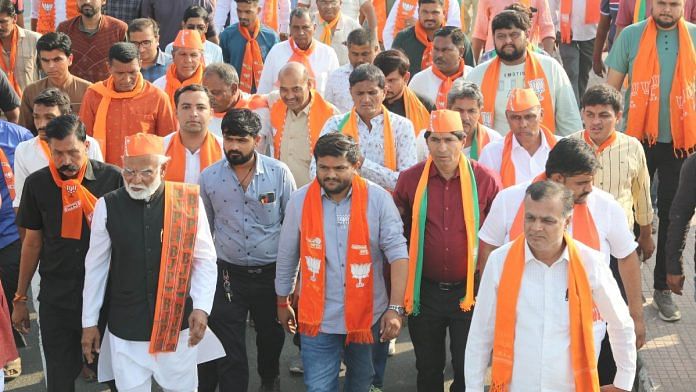New Delhi: They had played a crucial role in Bharatiya Janata Party’s (BJP) tally being reduced to 99 in 2017. Five years on, it is the Patidars among all the communities that ensured the BJP set a new record by breaching the 150-mark in Gujarat.
The extent of the community’s influence in the 2022 assembly elections can be gauged from the fact that 41 of the total 48 Patidar candidates fielded by the party — according to an internal analysis done by the BJP’s Gujarat unit — won from their seats, ThePrint has learnt.
Explaining the role of Patidars in BJP’s performance, a senior party functionary told ThePrint that the Congress gave tickets to 41 Patidar candidates but only three won while the Aam Aadmi Party (AAP), which was hoping to garner the support of the Patidar youth, gave tickets to 55 candidates out of which only 2 emerged victorious.
“As far as the OBC (Other Backward Class) community is concerned, the BJP gave tickets to 57 candidates of which 48 won. The Congress gave ticket to 49 OBC candidates out of which just 3 won, while the AAP gave ticket to 30 candidates but only 1 won,” a Gujarat BJP source said.
Patidars back in BJP fold
In all, Patidars constitute approximately 1.5 crore of Gujarat’s total population of 6.90 crore and are said to influence votes in close to 55-60 seats.
Of the 182 assembly seats in Gujarat, 48 are in Saurashtra region, the stronghold of the Patidar community. This time around the BJP won in 39 of the 48 seats, which also include seats that are not dominated by the Patidars.
In 2017, the Patidar agitation drove away the community from the BJP and hugely dented its position in the region. BJP won just 19 seats in Saurashtra that year as against 30 in 2012. The Congress won 28 seats in 2017, up from 15 in 2012. It played a part in bringing down the BJP’s overall tally to 99, the lowest so far.
With the 2017 quota agitation now long over and the Centre’s decision giving 10 per cent reservation for the economically weaker section (EWS) in general category jobs, the sentiment of the Patidar community changed in Gujarat and they decided to align themselves with the BJP.
“No one believed us when we said before the elections that the Patidars would vote for us wholeheartedly as all their major concerns were addressed by the BJP. Whether it is the youth or the overall population, the fact that we gave 10 per cent quota in jobs and education to the EWS among the ‘upper castes’, and the fact that in Gujarat, we also provided a special loan for them (those not covered under quota) whether it was for starting a new business or for educational purpose, was appreciated by all,” Gujarat BJP spokesperson Yamal Vyas said.
Another senior BJP leader said that during the door-to-door contact programme conducted by the Mahila Morcha, the party workers ensured that a tab was kept on whether the beneficiaries were getting the benefits on ground or not.
The BJP has been making concerted efforts to woo the Patidar community, the most politically influential community in Gujarat. In 2021, the party replaced chief minister Vijay Rupani with Bhupendra Patel. This year before the elections, it inducted Hardik Patel who had leaped into the spotlight with the 2015 Patidar agitation in Gujarat during which he fought for getting OBC status and reservation for the community.
Before the elections, PM Narendra Modi inaugurated a multi-specialty hospital in Rajkot, an area largely dominated by the Patidars. In addition to this, Union Home Minister Amit Shah, who spearheaded the Gujarat campaign, also categorically stated that CM Bhupendra Patel would be retained if the BJP comes to power again, something which is not common for the BJP to do.
The second BJP leader further said that apart from the Patidars, many other ‘upper caste’ communities, especially the women, also supported the BJP and its policies. “You have to understand that 2017 was an aberration and the community was angry but the BJP has resolved all their issues. At the same time, when the community saw that youth leaders like Hardik Patel joined the BJP they realised that only the BJP can work for their welfare,” he said.
Also Read: Quota stir long over & EWS to woo Patidars, but BJP’s leaving nothing to chance in Saurashtra
Dalit, tribal strike rate also high
The BJP also cornered the tribal and the Dalits votes with the help of candidates picked from these communities.
Of the 27 tickets that the party gave to tribal candidates, 23 won, the Gujarat BJP source quoted earlier said. In contrast, the Congress gave tickets to 28 tribal candidates out of which 3 won. There were 29 adivasi candidates fighting on AAP tickets but only 1 won.
“When it comes to Dalits, the BJP gave tickets to 13 candidates while 11 won. The Congress, on the other hand, gave tickets to 14 out of which 2 won while the AAP gave tickets to 13 candidates out of which only one won,” the BJP source added.
Upper castes also went with BJP
The upper castes, which includes Brahmins, Jains and Kshatriyas, continued to be the BJP’s traditional vote bank. Of the 37 tickets that the party gave to upper caste candidates, 33 won, the Gujarat BJP leader told ThePrint.
The Congress gave tickets to 50 upper caste candidates out of which 6 won while AAP fielded 52 but only one cleared the electoral test.
(Edited by Tony Rai)
Also Read: Why BJP’s overtures paid off in Gujarat tribal belt & Rahul’s outreach attempts failed



